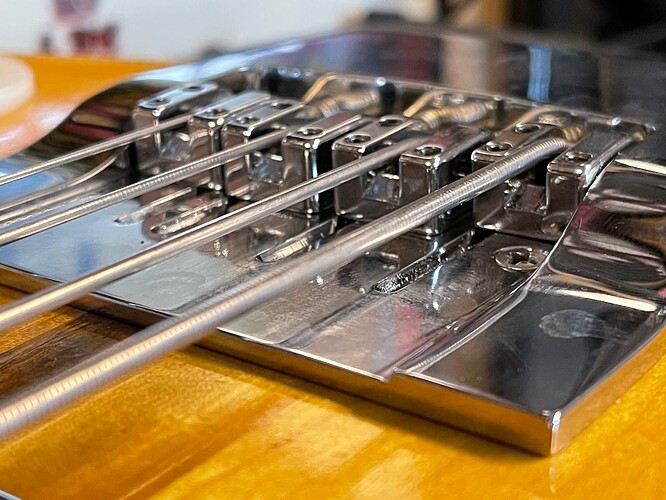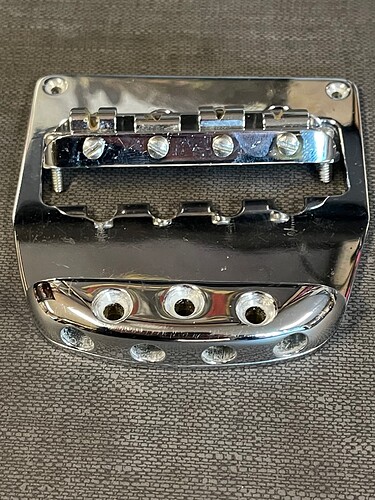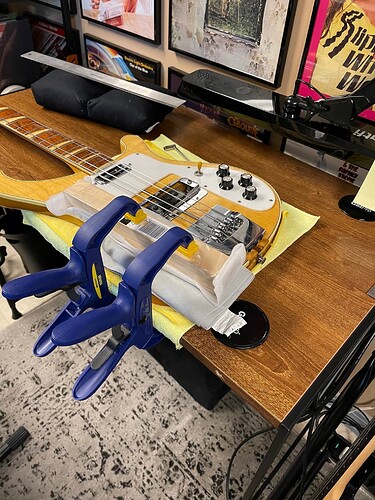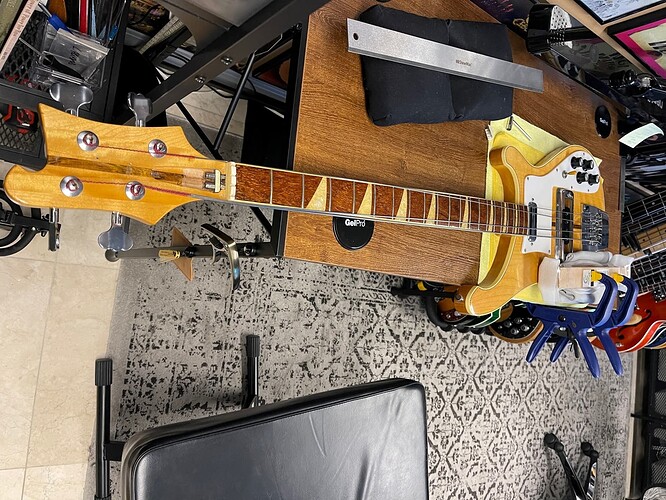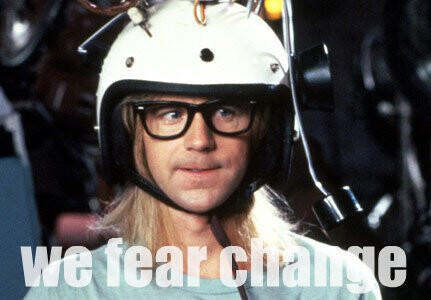Learning a lot about vintage Ricks and truss rods for sure.
Have not seen this topic here (many on talkbass, many wrong of course) so thought I would share the learning.
Read on if you are a bass repair / tech nerd…
The older 4003s and all 4001s use a unique dual truss rod system that works differently than what we mostly know as a “Fender” truss rod system.
Fenders et al, as you know, you simply turn something to bow or loosen the truss rod or rods (sometimes 2). That something can be a nut of some sort of a wheel at either the headstock end or the heel end of the neck.
Rickenbackers of older vintages use a dual truss rod system but it works entirely different. The tightening of the nuts does not change the bow of the truss rod, but instead ‘sets’ the neck where you physically put it. These truss rods are refered to as ‘hair pins’ sometimes. The problem is on the older Ricks (pre-1984 I think) is that the good folks at Rickenbacker used a fairly soft metal for this vs. something with a bit more strength, therefore creating some issues and lore around this topic.
Beyond being a bit more difficult to adjust (will get to that in a minute) this also results in what many end up wtih as a bass wtih higher than desired action. But the truss rod is not soley to blame here. The bridge plays a role too. The orignal V1 bridges were, and are, crap. This is a universally accepted concept and Hipshot has made a name for themselves again in this space as the go-to replacement. These under-engineered bridges (see the theme) can sometimes get what folks call ‘tail lift’, and pull themselves up on the bottom over time. They also are not the best for adjusting string height on, etc. In 2020, Rickenbacker redesigned the bridge.
My '72 Rick did not come with the original bridge, but came with an aluminum Hipshot and a Stars Guitars Rick/Alembic bridge. The Stars bridge (to me) is not very nice looking, and there are some bits missing and it is pretty mangled. The Hipshot is in good condition but needs some new screws as a couple are bent (easy).
The issue with the Hipshot and V2 style when it comes to action is that the strings are pretty darn high on the lowest settings. So if your weak truss rods and thin neck cannot 'pull back far enough to compensate for string tension, you have no room to ‘pull down’ the strings to something reasonable. I have a V2 on order, but from what I read, it suffers the same height adjustment issues.
The Stars Guitars bridge allows you to drop the entire saddle assembly, but does not allow for individual sting height adjustments (short of a file). (see screws under saddles, thes should be thumbscrews - which are missing)
Which brings us to strings.
Originally when these vintage Ricks first were sold, they cautioned using only Rick strings, and flats on top of that. Why? String tension vs. thin necks and weak truss rods. Rotosound round popularity is cited as the driving force for the truss rod and neck profile changes in order to compensate for increased string tension demands. A Rick bought today new has a much thicker neck (folks say baseball bat) vs the sleek thinner neck of vintage.
From my day-job engineering lens, this is a poorly designed system, at best, and just plain cheap, at worst. But, Rickenbackers are just damn cool.
So back to string action. If you can only set the neck ‘so far’ back/flat under tension, your baseline for string height may be higher than desired with no other levers to pull. And of course, can’t shim the neck as they are neck through.
So what does this all mean to anyone? Well, all this stuff, when looked at properly from an engineering perspective, makes perfect sense. But…enter the internet and lots of myths and you know what you get from that. Chaos.
I have spent the last few days researching like a mental patient so I don’t have to go wait in a month + long line at a luthier who knows what he is doing. If you think taking the neck off a vintage Fender to adjust the truss rod at the heel is a pain…well, that ain’t nuttin’.
When adusting the truss rod, you have to ‘set’ the neck in a postion WITHOUT string tension, that, when under string tension, brings the neck to a range where saddle height can be used to adjust string action height. Since there is no instantaneous feedback (need to tension strings to know if you are in the right place or not), this is a very long and iterative process vs. a ‘standard Fender truss rod’.
But there is another fun fact here. if you incorrectly adjust a Rick’s truss rod, you risk popping the fretboard off the neck! YIKES! As a new owner of an old Rick, this is a scary thought. (I actually think these Rick truss rods is where the unearned overall truss rod fear first came from, but have no proof.)
Short of two people working together, you need to rig up a clamp system to hold the bass in place, loosen the strings, loosen the truss rod nuts, move the neck (by holding down the fretboard in your fist and pushing down to where you think is the right place), and then tighten the truss rod nuts again and (sorta) hope you got it right. So how much force can/should you press down? So far for mine, it’s more than you think! Here is the setup I used to do this (after researching how others do it)…
With the Stars brige installed as it came, and DR Highbeams installed, (the action was 5/64" across the strings (measured at the 12th fret while fretting the first fret. But remember, this bridge has the ability to adjust the whole saddle piece down (big advantage). I cannot find tension numbers for these strings. They have since been placed in the garbage, so it doesn’t matter.
So I spent time getting to know my neck and truss rod nuts and pressing at various strengths, very very very cautiously. I think I did about 6 iterations. The hardest part is keeping the neck pressed down consistently while tightening the nuts.
How hard is too hard to press on the neck? - no idea, I did not want to find out.
How tight is too tight to tighten the truss rods? - no idea, I did not want to find out.
At the moment, with the Hipshot, the best I can get is about 6.5/64" on E, and 5/64" on G. Not bad and in the realm of what I like (usually around 7/64 on E for picking, 6/64 on E for fingerstyle, but 4/64" on G).
Good enough for now. I figure I will leave it here and check it as the season changes to summer, let it be happy where it is, and adjust more later. I have a V2 Rickenbacker bridge on the way as well to see if I like it better. i do like it cosmetically better than the Hipshot, but action will dictate.
As for the Stars bridge, its ugly, MacGyvered a bit and not preferred, but will hang onto it for a bit to see where it all nets out before deciding to sell or not.
So, if you are nerdy like me, all cool stuff.
